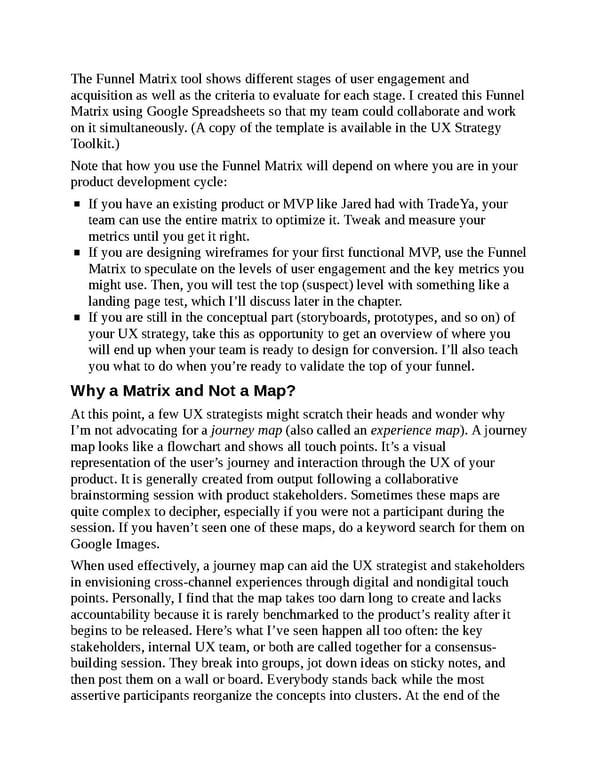The Funnel Matrix tool shows different stages of user engagement and acquisition as well as the criteria to evaluate for each stage. I created this Funnel Matrix using Google Spreadsheets so that my team could collaborate and work on it simultaneously. (A copy of the template is available in the UX Strategy Toolkit.) Note that how you use the Funnel Matrix will depend on where you are in your product development cycle: If you have an existing product or MVP like Jared had with TradeYa, your team can use the entire matrix to optimize it. Tweak and measure your metrics until you get it right. If you are designing wireframes for your first functional MVP, use the Funnel Matrix to speculate on the levels of user engagement and the key metrics you might use. Then, you will test the top (suspect) level with something like a landing page test, which I’ll discuss later in the chapter. If you are still in the conceptual part (storyboards, prototypes, and so on) of your UX strategy, take this as opportunity to get an overview of where you will end up when your team is ready to design for conversion. I’ll also teach you what to do when you’re ready to validate the top of your funnel. Why a Matrix and Not a Map? At this point, a few UX strategists might scratch their heads and wonder why I’m not advocating for a journey map (also called an experience map). A journey map looks like a flowchart and shows all touch points. It’s a visual representation of the user’s journey and interaction through the UX of your product. It is generally created from output following a collaborative brainstorming session with product stakeholders. Sometimes these maps are quite complex to decipher, especially if you were not a participant during the session. If you haven’t seen one of these maps, do a keyword search for them on Google Images. When used effectively, a journey map can aid the UX strategist and stakeholders in envisioning cross-channel experiences through digital and nondigital touch points. Personally, I find that the map takes too darn long to create and lacks accountability because it is rarely benchmarked to the product’s reality after it begins to be released. Here’s what I’ve seen happen all too often: the key stakeholders, internal UX team, or both are called together for a consensus- building session. They break into groups, jot down ideas on sticky notes, and then post them on a wall or board. Everybody stands back while the most assertive participants reorganize the concepts into clusters. At the end of the
 UX Strategy: How to Devise Innovative Digital Products that People Want Page 248 Page 250
UX Strategy: How to Devise Innovative Digital Products that People Want Page 248 Page 250